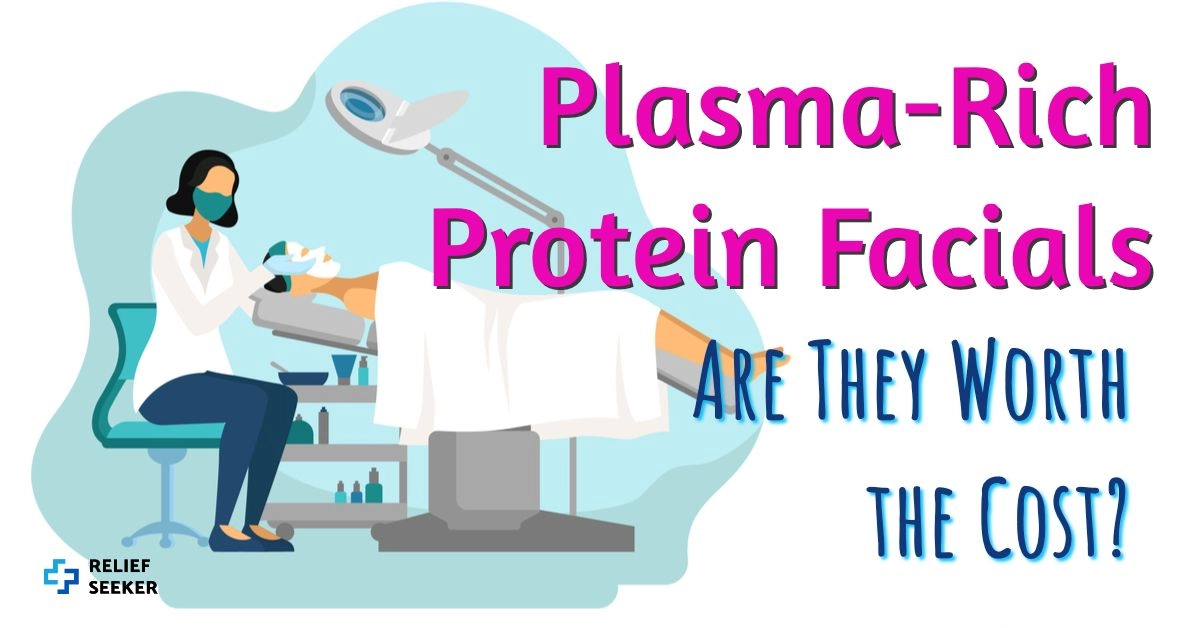Plasma-rich protein (PRP) facials are the newest trend. Also known as the blood facial and the VampireFacial (or the vampire facelift), this cosmetic procedure uses platelet-rich plasma extracted from your own blood to help encourage facial collagen growth.
A dermatologist uses a machine with tiny needles to puncture small holes in your skin before applying the platelet-rich plasma. PRP facials are used to treat wrinkles, fine lines, melasma, acne scarring, and more.
But what are the downsides to this treatment? What does a PRP facial cost? And do these facials even work?
What Does a PRP Facial Do?
PRP facials can treat a long list of skin issues and conditions, including acne, scarring, melasma, rosacea, patchy skin, and more.
The procedure is based on medical research; in trials, doctors have extracted the blood plasma from injured athletes and injected that plasma into torn ligaments to speed up the healing process.
PRP facials are similar in that doctors extract plasma to inject into your dermis. Even though the skin on your face may not be damaged, the collagen (the protein that heals skin and wounds) and elastin (the protein that makes skin supple) in your skin are either damaged or failing to produce.
Injecting protein-rich plasma into your skin can help rebuild collagen and create new collagen, leading to springy, plump, and youthful-looking skin.
PRP Facial Process
These treatments are medical (not cosmetic) treatments, meaning you’ll need to head to a certified dermatologist’s office to get in on the craze.
A doctor’s assistant or dermatologist will draw your blood, place the blood vials into a coagulator, and extract the plasma by spinning the vials for several seconds. Your dermatologist will then apply a topical numbing cream to your face before making tiny puncture marks all over your face with a microneedle machine.
The final step is applying your plasma to your face. Massaging the plasma into your skin is the last step of the treatment.
PRP Facial Pros and Cons
PRP facials are certainly all the rage right now, but are they worth the hype? There are plenty of pros and cons to consider before booking this treatment, including cost, recovery time, side effects, and typical results.
PRP Facial Pros
Aids in collagen rebuilding/repair
Creates new elastin
Uses your own platelets to repair tissue
Treats a long list of skincare issues
Based on medical research
Little down-time
Few side effects and risks
Results last up to two years
PRP Facial Cons
Treatments are extremely expensive
May need three or more treatments
Results not guaranteed
Needs a significant amount of blood to work
Not enough research to back up scientific claims
PRP Facial Vs Microneedling
PRP facials and microneedling are often confused for one another. This is because microneedling is a step in the PRP facial that allows your skin to quickly absorb the nutrient-rich plasma.
Normally, a microneedling device is used in facials to increase collagen production. Creating tiny punctures or wounds can help stimulate collagen growth. Sometimes the treatment includes skincare products (such as serums, moisturizers, or oils) to help boost collagen production even further.
At-home microneedling devices are also sold to even skin texture and allow for faster absorption of both OTC and prescription skincare products.
Conditions PRP Facials Treat
PRP facials can treat a long list of skin conditions and issues. The most common conditions treated using PRP include fine lines and wrinkles, acne scars, and melasma.
Since the procedure is used to stimulate collagen and elastin production, PRP is best used to treat any skin condition related to low cell turnover.
In addition to facial skin conditions, PRP treatments are also used to reduce the appearance of stretch marks.
Fine Lines and Wrinkles
Most people seek PRP facials to smooth fine lines and wrinkles. These two conditions are directly related to low collagen production and damaged collagen and elastin.
As we age, our bodies don’t produce as much collagen and elastin. This can be exacerbated through sun exposure, dehydration, environmental factors, and hormonal imbalances. The likelihood of developing premature wrinkles and fine lines is also passed down through DNA.
Fine lines and wrinkles are often exacerbated by sun damage.
Melasma
Another common condition treated by PRP facials is melasma.
Melasma is the result of patches of pigment in the skin, caused by genetics, overexposure to the sun, hormonal fluctuations, and some medications. This condition creates dark patches all over the skin, especially on the face, neck, and chest.
Sometimes melasma goes away on its own. Pregnant women often suffer from this condition as the result of fluctuating hormones, and the melasma goes away after hormone levels return to normal.
Yet if your melasma is caused by environmental issues or if it’s lasted longer than one year, you may want to speed up the recovery process with an in-office or at-home treatment.
Patchy Skin/Rosacea
PRP facials may also help reduce the appearance of patchy skin and rosacea.
Since rosacea is caused by a variety of internal factors (such as stress, spicy foods, alcohol, and allergens), topical treatments such as facials may not be able to address all skin reddening issues.
Before booking an appointment for a PRP facial, opt for a consultation with your dermatologist to determine if a cosmetic treatment will actually help soothe your red or patchy skin.
Acne/Acne Scars
Acne scarring is another condition commonly treated with PRP facials.
Acne scars are formed when the skin doesn’t create enough collagen or when it creates too much collagen after a breakout. The skin can’t heal properly without the right amount of collagen, and either pockmarks or small bumps and ridges form.
PRP facials are known to smooth rough skin and even the skin tone and skin texture. The microneedling creates small wounds on the face, and the PRP stimulates collagen production, allowing the skin cells to rejuvenate and grow back at a healthy rate.
PRP Facial Results
PRP facial results depend on the severity of your skin condition, the number of treatments, and treatment add-ons.
Since you may need to undergo several facials to see results, some dermatologists recommend getting botox or fillers at the time of your facial or between facials for the most dramatic results.
Since the facial stimulates collagen growth, some of the most dramatic results are usually seen with conditions such as acne scarring, wrinkles, patchy skin, and other issues related to poor cell turnover.
You’ll need to consult with a dermatologist to determine the exact number of treatments and to get a better idea of typical results for patients with your skin condition.
How Long Does a PRP Facial Last?
After your final treatment (experts state that you may need up to three or more treatments), you shouldn’t need another treatment for at least another 18-to-24 months — making PRP one of the most long-lasting skincare treatments.
Again, results may vary based on the severity of your skin condition, the number of initial treatments, and any add-on treatments or fillers.
Many patients still get Botox injections and fillers between PRP facials to ensure their results last as long as possible.
PRP Facial Downtime
PRP facials have little-to-no downtime or recovery time. You won’t need to be accompanied to the dermatologist’s office and should be able to drive yourself home after the procedure.
Your face will look extremely red for a few days, so you may want to avoid big events or photo opportunities for up to a week after the procedure. Since only your blood platelets are used to stimulate collagen growth, you won’t walk out of the office with a ‘bloody’ face.
Yet, many patients claim that their faces look somewhat bloody because of the redness and irritation from the microneedling.
You’ll want to avoid the sun for the week following your treatment. Don’t apply any products to your skin for up to seven days after your facial.
PRP Facial Side Effects
The most common side effects of PRP facials include bruising, inflammation, redness, swelling, and pain. Most side effects should subside within a week, and there is virtually no downtime.
The most serious side effects of PRP facials are actually caused by microneedling — and not the application of plasma. Since the plasma applied to your face is your plasma, you shouldn’t experience any allergic reactions or harsh side effects from the plasma itself.
Microneedling side effects may include infection, scarring, itching, and redness.
Anyone that has herpes or is prone to cold sores should tell their doctor or dermatologist before the procedures, as they may be more prone to complications.
PRP Facial Cost
One of the biggest downsides to PRP facials (or any in-person dermatology treatment) is the cost. These facials are nearly twice the cost of microneedling and almost seven times the cost of microdermabrasion.
If cost is a major concern, you may want to opt for at-home treatments or in-person treatments that don’t come with all the hype of a PRP facial.
PRP Facial Cost
PRP treatments cost around $750 each. A series of three treatments will cost nearly $3,000 every 18-to-24 months.
Microneedling Cost
Plasma-free microneedling costs around $350 per treatment. You may need several treatments to see results, and results last up to two months.
PRP Facial Alternatives
If you’re put off by the high price of PRP facials, the number of recommended treatments, and intense facial reddening, you’re not alone. The price tag alone creates a barrier between the average person and PRP facials.
Luckily, you can get similar results without the blood draw, a trip to the dermatologist’s office, tiny needles, and high cost. These PRP facial alternatives can fix your skin issues and still keep a little money in your pocket.
Prescription Skincare
One of the most effective treatments for rosacea, acne, melasma, scarring, and wrinkles is prescription skincare.
This treatment costs a fraction of most in-person treatments and is personalized for your skin type and skin issues. Simply fill out a form online, chat with a dermatologist from the comfort of your own home, and get your treatment mailed right to your home or office.
Prescription skincare is more effective than over-the-counter (OTC) skincare because it’s personalized for your skin type. OTC products contain the same amount of active ingredients for the average person, meaning you’ll often get too much or too little of an active ingredient in each dose.
Depending on the treatment you’re prescribed, you may end up with a skincare regimen, spot treatment, peel, or night cream.
Prescription Skincare Cost
Companies like Musley and Rory charge $30-to-$100 a month for personalized prescription skincare. Total fees include a doctor consultation and shipping.
Microdermabrasion
Microdermabrasion is a popular treatment that involves removing the top layer of skin, stimulating collagen regrowth, and encouraging cell turnover. It has little-to-no downtime, and redness or irritation should only last for a few days.
This treatment is best for removing acne scars, lightening melasma, and reducing the appearance of wrinkles.
You can also purchase at-home microdermabrasion products that are less invasive and don’t remove so much dead skin.
Microdermabrasion Cost
Most dermatologists charge between $100 and $300 for microdermabrasion (depending on the type of microdermabrasion and your location).
Fillers/Botox
Fillers and Botox injections are popular for smoothing fine lines and wrinkles. Botox injections relax the muscles of the face, preventing wrinkles and smoothing fine lines. Fillers increase the amount of hyaluronic acid in the skin, creating a plump, firm look.
Botox and fillers last for a few months, so you’ll need to head to your dermatologist’s office a few times a year.
Fillers/Botox Cost
Botox costs $10-to-$15 per unit (you may need several hundred units per session). Fillers cost up to $1,000 per session.
OTC Skincare
OTC skincare is available at most drugstores, big-box stores, department stores, and cosmetic retailers. It’s easily accessible, there are practically no financial barriers, and you can purchase exactly what you need.
The biggest downside to OTC skincare is that it isn’t personalized. You may end up with too much or too little of an active ingredient. Or, you may end up with the entirely wrong product altogether.
OTC Skincare Cost
Costs vary depending on brand and ingredients; you’ll find OTC products for under $10 and for well over $100.


